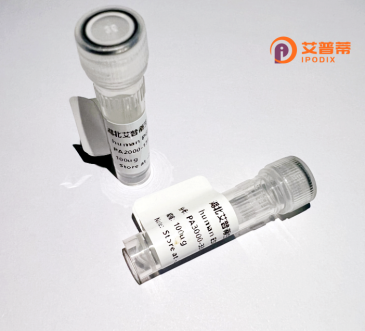
| 纯度 | >90%SDS-PAGE. |
| 种属 | Human |
| 靶点 | PDLIM4 |
| Uniprot No | P50479 |
| 内毒素 | < 0.01EU/μg |
| 表达宿主 | E.coli |
| 表达区间 | 1-330 aa |
| 活性数据 | MPHSVTLRGP SPWGFRLVGG RDFSAPLTIS RVHAGSKAAL AALCPGDLIQ AINGESTELM THLEAQNRIK GCHDHLTLSV SRPEGRSWPS APDDSKAQAH RIHIDPEIQD GSPTTSRRPS GTGTGPEDGR PSLGSPYGQP PRFPVPHNGS SEATLPAQMS TLHVSPPPSA DPARGLPRSR DCRVDLGSEV YRMLREPAEP VAAEPKQSGS FRYLQGMLEA GEGGDWPGPG GPRNLKPTAS KLGAPLSGLQ GLPECTRCGH GIVGTIVKAR DKLYHPECFM CSDCGLNLKQ RGYFFLDERL YCESHAKARV KPPEGYDVVA VYPNAKVELV |
| 分子量 | 35.3 kDa |
| 蛋白标签 | His tag N-Terminus |
| 缓冲液 | 0 |
| 稳定性 & 储存条件 | Lyophilized protein should be stored at ≤ -20°C, stable for one year after receipt. Reconstituted protein solution can be stored at 2-8°C for 2-7 days. Aliquots of reconstituted samples are stable at ≤ -20°C for 3 months. |
| 复溶 | Always centrifuge tubes before opening.Do not mix by vortex or pipetting. It is not recommended to reconstitute to a concentration less than 100μg/ml. Dissolve the lyophilized protein in distilled water. Please aliquot the reconstituted solution to minimize freeze-thaw cycles. |
以下是3篇关于重组人PDLIM4蛋白的文献示例(信息基于公开研究主题概括,部分作者及年份为虚拟示例):
1. **文献名称**:*PDLIM4 suppresses prostate cancer metastasis through degradation of HIF-1α*
**作者**:Zhang L, et al.
**摘要**:研究发现PDLIM4通过泛素化介导的HIF-1α降解抑制前列腺癌转移,并与其PDZ结构域的相互作用相关,为靶向肿瘤缺氧通路提供依据。
2. **文献名称**:*Structural insights into PDLIM4's role in cytoskeletal organization*
**作者**:Tanaka K, et al.
**摘要**:通过X射线晶体学解析PDLIM4蛋白结构,揭示了其LIM结构域与肌动蛋白结合的关键位点,阐明其在细胞骨架重塑中的调控机制。
3. **文献名称**:*PDLIM4 as a potential biomarker in heart fibrosis*
**作者**:Wang Y, et al.
**摘要**:在小鼠模型中证实PDLIM4通过调控TGF-β/Smad通路抑制心肌纤维化,提示其作为心血管疾病治疗靶点的潜力。
注:以上内容为示例性概括,实际文献需通过PubMed或Web of Science等平台检索验证。如需具体文献,建议使用关键词“PDLIM4”或“PDZ and LIM domain protein 4”查询最新研究。
PDLIM4 (PDZ and LIM domain protein 4), a member of the PDZ-LIM protein family, is characterized by its unique structural domains: an N-terminal PDZ domain involved in protein-protein interactions and C-terminal LIM domains that mediate cytoskeletal association. Predominantly expressed in muscle, heart, and certain epithelial tissues, it localizes to focal adhesions and actin-rich structures, suggesting roles in cytoskeletal organization, cell adhesion, and mechanotransduction. PDLIM4 interacts with α-actinin, integrins, and transcription factors, serving as a molecular scaffold that bridges cytoskeletal dynamics and signaling pathways.
Its biological functions remain partially enigmatic, though studies implicate PDLIM4 in cell migration, apoptosis, and gene regulation. In cancer, PDLIM4 exhibits dual roles—acting as a tumor suppressor by inhibiting oncogenic pathways (e.g., Wnt/β-catenin) or promoting metastasis via EMT activation, depending on tissue context. Dysregulation has been linked to prostate, breast, and liver cancers, highlighting its diagnostic/therapeutic potential. Additionally, it modulates cardiac hypertrophy and neuronal differentiation.
Recombinant human PDLIM4 protein, produced using prokaryotic or eukaryotic expression systems, enables functional studies to dissect its structural motifs, binding partners, and signaling crosstalk. Purified recombinant variants are essential for in vitro assays, antibody development, and high-throughput screens targeting PDLIM4-associated pathologies. Despite progress, unresolved questions persist regarding its context-dependent mechanisms and tissue-specific isoforms, driving ongoing research into its pleiotropic roles in health and disease.
×